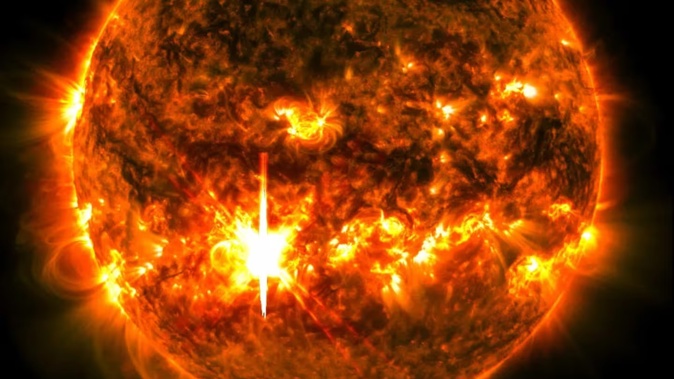
- Nasa has just observed an unusually intense solar flare – facing in Earth’s direction when it was discharged from the Sun.
- An expert says it could soon result in a geomagnetic storm, visible as auroras in our night skies.
- That would come at a “perfect time” when our night sky is at its darkest – and the Earth and Sun’s magnetic fields are “coupled”.
Astro-photographers could soon be in for another treat, with the potential for an unusually intense solar flare to eventually light up our night skies.
Solar flares are powerful bursts of radiation and energy blasted from the Sun’s surface when built-up magnetic energy is suddenly released.
They often happen near sunspots, where the Sun’s magnetic fields are particularly strong.
This week, Nasa’s Solar Dynamics Observatory reported the discharge of an X7.1 flare, placing it in the most intense category.
One of the largest events recorded in modern times, this flare appeared to be directed toward Earth at the time of its release.
Particularly when such flares are accompanied by coronal mass ejections, they can release massive clouds of charged particles, or plasma, that travel through space and interact with Earth’s magnetic field.
This activity can lead to geomagnetic storms, which, in turn, can trigger dazzling auroras visible in our night skies.
An event in May happened to be the biggest solar storm observed for more than a decade, reaching top-of-the-scale “G5″ status.
While Earth’s magnetic field shields us from particles from such storms, they’re known to cause problems for power grids by sending extra electrical current down transmission lines – as happened when a Dunedin transformer was knocked out in 2001.
But solar storms could also prove a delight for stargazers and photographers – and astro-photographer and Otago Museum director Dr Ian Griffin said we could expect to know soon whether this flare resulted in one.
“This is a really big solar flare, which means there’s a good chance for auroras in a couple of days – we’ll probably know more in a day or so once satellites start to detect it,” Griffin said.
“It’s exciting that we’re in a new moon phase – so the aurora could be quite good, as we’ll see them against a dark sky.
An event in May happened to be the biggest solar storm observed for more than a decade, reaching top-of-the-scale “G5″ status. Photo / Paul Taylor
“We’re also at a perfect time of year, when our magnetic field and the sun’s magnetic field are coupled, and where we tend to get better auroras.
“So, if you’re up in Auckland, there might even be a chance you might see it, much like that brilliant aurora back in May.”
The flare comes as a team of Kiwi scientists have been working with the energy sector on a $15 million project aimed at preparing for a much larger event than May’s – a so-called “solar tsunami”.
The most powerful solar tsunami in recent times – the 1859 “Carrington Event” - could have caused widespread damage to gas and electricity networks, and railway signals, if it happened today.
Another solar storm in 2012 was of similar magnitude, but it passed Earth’s orbit without striking the planet.
Jamie Morton is a specialist in science and environmental reporting. He joined the Herald in 2011 and writes about everything from conservation and climate change to natural hazards and new technology.
Take your Radio, Podcasts and Music with you









